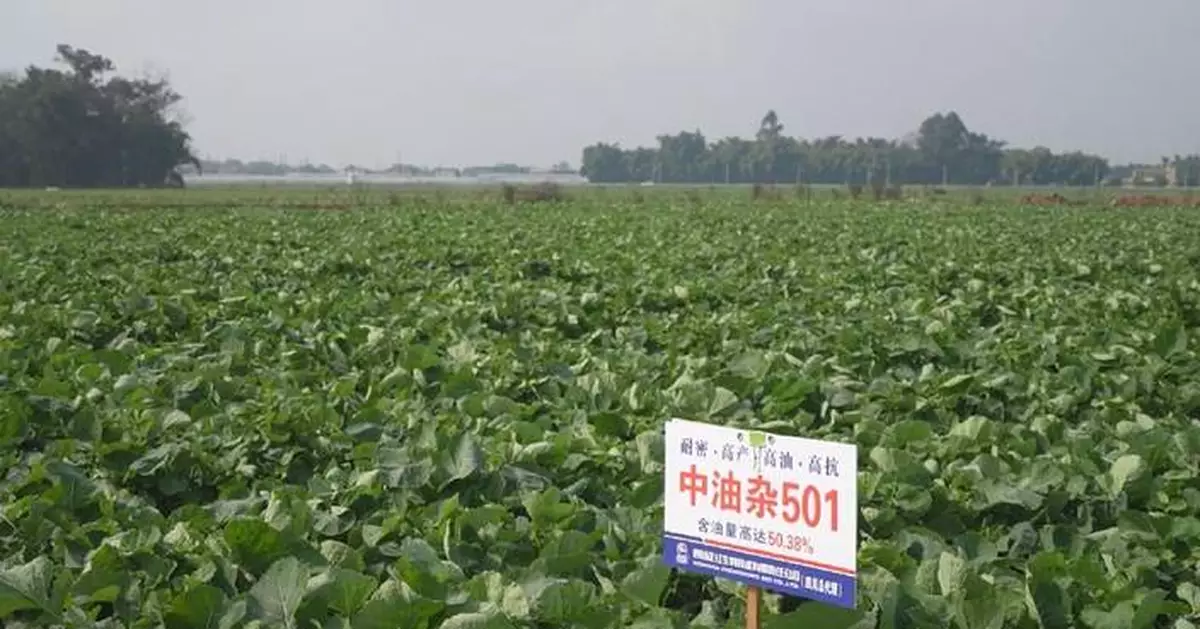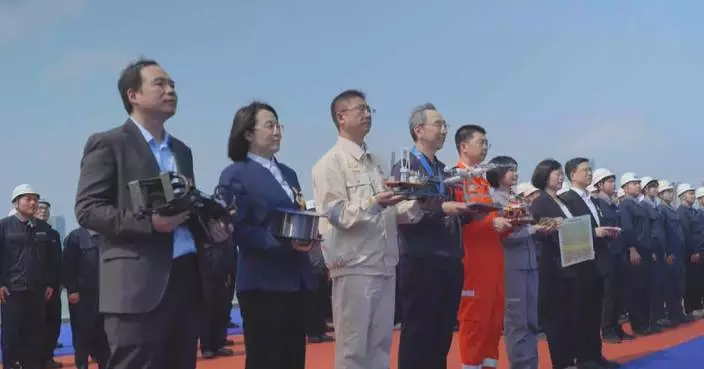A new rapeseed variety developed by the Chinese Academy of Agricultural Sciences (CAAS) has been widely planted in Meishan City of southwest China's Sichuan Province, reporting a significant increase in yield per unit, further enhancing China's food security.
In 2024, China launched a national initiative aiming to improve per-unit yield for grain and oil crops. According to the annual statistics, the average food yield per hectare in 2024 has increased by 76.5 kilograms compared with 2023.
To further ensure domestic food security, China's "No. 1 central document" for 2025, unveiled on Sunday, reiterated the need to promote the large-scale yield improvement initiative, expand the implementation scale, and further advocate high-yield and efficient farming models. By introducing new varieties and high-density planting techniques, the rapeseed field in Meishan is among the leading models.
Compared with ordinary rapeseed plant varieties, whose best plant density is around 225,000 plants per hectare, the new variety requires a tighter row spacing from 33 to 35 centimeters to 27, thus nearly doubling the density, raising the number to 450,000.
The oil content of its seeds also reached over 50 percent, ranking among the top compared with major rapeseed varieties planted across China.
In 2024, the National Development and Reform Commission announced a new initiative to increase grain production by 50 million metric tons by 2030. Improving the per unit yield of grains and oil crops is vital to achieving the 2030 goal, while developing new varieties, and adopting new techniques, equipment, and agriculture models are critical approaches, said an expert.
"We need to increase the per unit yield, and we are capable of doing it. In view of our practical results, we should speed up efforts to sum up the experiences from the past two years of pilot projects, form a set of effective technological integration models and best practices, and transform these experiences into systematic methodologies for broader application. This will play a significant role in ensuring national food security and firmly securing China's food supply," said Zhong Yu from the Agricultural Economy Institute, CAAS.

China's new rapeseed variety increases yield, enhances food security
U.S. tariffs on Cambodia, which were set at 49 percent, have sparked concerns among the Southeast Asian country's key export industries such as garment manufacturing amid the ensuing economic uncertainties.
On April 2, U.S. President Donald Trump announced the 49 percent "reciprocal tariff" on goods imported from Cambodia, the highest among all countries. Days later, the U.S. reduced the so-called "reciprocal tariff" to 10 percent for 90 days, offering a window period to Cambodia for negotiations with it.
Cambodian businesspeople say the tariffs have the potential to wreak havoc on the country's manufacturing sector, which, according to data from the World Bank, makes up around a fifth of the country's GDP.
"For U.S. manufacturers, definitely, there will be a big impact. If manufacturers are focusing on U.S. products, they are now in the middle. They don't know what they should do at the moment because the tariff now from Cambodia to the U.S. is actually quite high," said Dr. Ben Li, a Hong Kong investor in Cambodia and Chairman of the Cambodia Chinese Commerce Association.
Nevertheless, Li sees the tariff hike as an opportunity to export more Cambodian goods to the European Union, where a majority of Cambodian exports enjoy duty-free status.
"I always say there will be a light (at the end of the tunnel.) Even now, the U.S. tariff is so high, it's going to be so high after 90 days, we don't know. But, there's still a big market to Japan or to the European Union. There's still a big opportunity there," he said.
The Cambodian investor also believes the development of major infrastructure projects will help support Cambodia's economy.
"Especially the new canal and then the new airport, and the railways which connect to China. I believe once the logistics and infrastructure are built up, it can help the whole country's economy. By reducing the transportation costs, it can also mitigate the tariff costs," he said.
Cambodia and the U.S. held their first tariff negotiations on April 16, with more expected to follow. Local experts said the stakes are high for the country's workers.
"If this negotiation fails, there will be a significant impact. It will include the garment and travel goods sector. These sectors consist of about 1,068 factories and 930,000 workers. The income generated from these sectors is about 3 billion dollars per year. So it would significantly impact Cambodia's economy, jobs and incomes," said Chey Tech, a socio-economic research and development consultant from Dynamic Alliance Consulting.
Despite the potential risks, Tech expressed his optimism about a positive outcome, citing Cambodian Prime Minister Hun Manat's letter to Trump on April 4.
"The Prime Minister's letter confirmed that Cambodia would reduce the tariff rate for U.S. goods to 5 percent. Second, Cambodia is the least developed country. Third, Cambodia produces goods that the developed countries won't produce. We asked whether the U.S. would be able to produce these low-cost products. It cannot," said Tech.
In 2024, Cambodia exported goods of 9.9 billion dollars to the U.S., making it the country's largest market, accounting for 37 percent of Cambodia's total exports.

49-percent US tariffs sparks worry among Cambodia's key export industries




















































